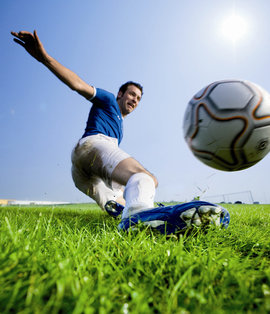The Netherlands
October 14, 2016
 In the Netherlands, a heated discussion is going on about the potential health risks of artificial grass because of its rubber infill. Scientists found reasons to believe that this infill could increase the risk of cancer. Following this discussion, it has become more than relevant to focus on the current state of affairs in natural grass. An awful lot of research has been carried out in the natural grass industry the past few years, and many innovations have been introduced. What’s the outcome of all that research? With the proper maintenance, the latest natural grasses offer an excellent and cheaper alternative to artificial grass.
In the Netherlands, a heated discussion is going on about the potential health risks of artificial grass because of its rubber infill. Scientists found reasons to believe that this infill could increase the risk of cancer. Following this discussion, it has become more than relevant to focus on the current state of affairs in natural grass. An awful lot of research has been carried out in the natural grass industry the past few years, and many innovations have been introduced. What’s the outcome of all that research? With the proper maintenance, the latest natural grasses offer an excellent and cheaper alternative to artificial grass.
More playing hours
Natural grass has improved tremendously in the field of wear tolerance the past few years. Whereas sports pitches could often be used for only 250 hours a year in the past, a pitch sown with the latest grass varieties can now tolerate at least 450 hours of playing.
Better for the environment
Natural grass is also a good choice as far as the environment is concerned. With proper upkeep, natural grass is a sustainable, environmentally and CO2 friendly product. For example, natural grass binds greenhouse gases from the atmosphere in the soil, exchanging them for oxygen. A grass seed mixture may have a strong influence on the turf’s sustainability. Nowadays, there are grass varieties with characteristics such as excellent disease resistance, drought tolerance and utilisation of minerals. These characteristics enable savings in, for example, pesticides, water and fertilisers.
Lower costs
Creating an artificial grass pitch will cost around 400,000 euros. A pitch of natural grass is much cheaper, involving only about 80,000 euros. There’s also a large difference in the annually recurring costs. The costs involved in the upkeep and depreciation of a natural grass pitch amount to about 14,000 euros a year, and those of an artificial one to around 42,000 euros.
The natural choice
In short, natural grass scores high on all fronts. And then there’s also the way in which natural grass is perceived and experienced: real grass smells and feels good, many sports enthusiasts prefer playing on natural grass, and it also causes fewer injuries. All in all, it eliminates any need for artificial grass.
Innovaties in gras maken kunstgras overbodig
Naar aanleiding van de discussie over kunstgrasvelden is het meer dan relevant om een licht te schijnen op de huidige stand van zaken omtrent natuurgras. De natuurgrasindustrie heeft de afgelopen jaren namelijk niet stilgezeten en een tal van innovaties geïntroduceerd. Wat blijkt? De nieuwste natuurgrassen bieden, bij goed onderhoud, een uitstekend en zelfs goedkoper alternatief voor kunstgras.
Meer speeluren
Op het gebied van bespelingstolerantie heeft natuurgras in de afgelopen jaren een enorme groei doorgemaakt. Waar sportvelden vroeger slechts 250 uur per jaar bespeeld konden worden, kan tegenwoordig een veld met de nieuwste grasrassen al minstens 450 speeluren aan.
Beter voor milieu
Ook met het oog op het milieu is natuurgras een goede keuze. Bij gedegen onderhoud is natuurgras een duurzaam, milieu- en CO2-vriendelijk product. Zo legt natuurgras broeikasgassen uit de lucht vast in de bodem en geeft hier zuurstof voor terug. Bovendien kan de keuze voor het juiste graszaadmengsel van grote invloed zijn op de duurzaamheid van de mat. Er bestaan tegenwoordig grassen met eigenschappen als uitstekende ziekteresistentie, droogtetolerantie en mineralenbenutting. Door deze eigenschappen kan er bespaard worden op bijvoorbeeld pesticiden, water en meststoffen.
Lagere kosten
De aanleg van een kunstgrasveld kost al snel zo’n 400.000 euro. Een natuurgrasveld is in dit opzicht veel goedkoper: de aanlegkosten hiervan bedragen ongeveer 80.000 euro. Wat betreft de jaarlijks terugkerende kosten vormt zich tussen kunst- en natuurgras nog een groot verschil: de onderhouds- en afschrijvingskosten voor een natuurgrasveld bedragen jaarlijks zo’n 14.000 euro, tegenover 42.000 euro voor een kunstgrasveld.
De natuurlijke keuze
Natuurgras scoort dus op alle fronten. Vergeet daarnaast niet de beleving van natuurgras: écht gras ruikt én voelt lekker, speelt volgens veel sporters beter en zorgt voor minder blessures. Kortom: het maakt kunstgras overbodig.